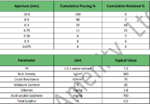I haven't seen anyone talk about these (probably a good reason) but would like to attempt to get anyone's experiences, opinions, anecdotal observations. If you have run across these at any point in time, used them or thought of using them please comment. I don't want to reform on the sound ideal mixes or the components therein; I simply want to start a (hopefully) fun discussion on the possibilities of the, passed over or unheard of by the majority, soil components we don't consider.
1. Perlite (unprocessed, non popped, and just out of the mine)- being unprocessed, this is obviously much heavier than horticultural perlite. I found someone selling small inexpensive boxes of golfball sizes pieces on ebay so I decided to get a few bust some up, sieve and experiment. I have found it to be very similar to pumice in texture and density.
2. Sandstone- I believe everyone knows what this is. Its all over everywhere, there are different densities ranging from fragile falls to dust in your hand to keeps it's form and holds water similar to LECA.
3. Dacite- falling somewhere between granite and pumice in weight and water holding capabilities this rock is loudly touted by the author of the stone eaters cactus soil article (I believe from Italy) who also advocated for the use of traditional bonsai soil components (akadama, kanuma, and chabasai) in soil mixes to be used for some of the more difficult to keep cacti species. Perhaps it could be useful in bonsai as well. I found a small inexpensive box of golfball sized chunks on eBay from the same seller as the perlite and, while it's been more difficult to break up and sieve than the perlite, I did it and I am now planning to experiment.
4. Mica
5. Mica schist
6. Volcanic tuff
7. Granadiorite
While I'm mainly interested in inert inorganic components, feel free to comment on anything that you've been curious about as well. Ill add to this list and take pictures of the busted/sifted components in the future if this topic piques anyone's interest.
1. Perlite (unprocessed, non popped, and just out of the mine)- being unprocessed, this is obviously much heavier than horticultural perlite. I found someone selling small inexpensive boxes of golfball sizes pieces on ebay so I decided to get a few bust some up, sieve and experiment. I have found it to be very similar to pumice in texture and density.
2. Sandstone- I believe everyone knows what this is. Its all over everywhere, there are different densities ranging from fragile falls to dust in your hand to keeps it's form and holds water similar to LECA.
3. Dacite- falling somewhere between granite and pumice in weight and water holding capabilities this rock is loudly touted by the author of the stone eaters cactus soil article (I believe from Italy) who also advocated for the use of traditional bonsai soil components (akadama, kanuma, and chabasai) in soil mixes to be used for some of the more difficult to keep cacti species. Perhaps it could be useful in bonsai as well. I found a small inexpensive box of golfball sized chunks on eBay from the same seller as the perlite and, while it's been more difficult to break up and sieve than the perlite, I did it and I am now planning to experiment.
4. Mica
5. Mica schist
6. Volcanic tuff
7. Granadiorite
While I'm mainly interested in inert inorganic components, feel free to comment on anything that you've been curious about as well. Ill add to this list and take pictures of the busted/sifted components in the future if this topic piques anyone's interest.

